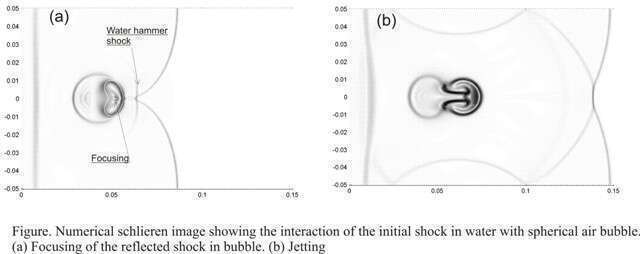Shock induced bubble collapse in water is investigated numerically. An accurate and robust semi-conservative volume-fraction based numerical algorithm is used to study the interaction of a plane shock in water with cylindrical and spherical air cavities. The numerical scheme is based on a system of compressible Euler equations with separate equations of state for water and gas. The interface between the two phases is described by the volume fraction function and its evolution is governed by an advection equation. The semi-conservative form of the governing equation is chosen to avoid the spurious pressure oscillations at the interface between the two fluids well-known for the conservative formulation of the problem. The present numerical scheme shows interesting details of shock propagation through water and air bubble including shock focusing process of the transmitted shock within the gas bubble as well as generation of a high speed liquid jet in the later stages of the process.
The purpose of the present numerical study is to obtain a deeper understanding of non-symmetric shock induced collapse of air bubble in water. This problem is directly connected to the problem of erosion damage due to non-symmetric bubble collapse near solid surfaces. Another interesting physical aspect of the problem is the propagation and focusing of the induced shock in the gas bubble. Even a weak shock in liquid water phase with a Mach number of 1.1-1.2 will induce a strong shock with Mach number of order of 5 due to the large difference in the speeds of sound between the liquid and the gas phase. The strength of the induced shock in the bubble will be further amplified after reflection off the rear spherical surface of the bubble followed by a shock focusing in the region at the distance of a half bubble radius from the wall. This focusing process results in a substantial increase of pressure and temperature in the focal region. Interaction of the initial shock in water with the bubble results in the non-spherical deformation of the bubble surface and involves the formation of a high-speed liquid jet in the direction of the propagation of the initial shock. The large amount of structural damage caused by bubble collapse near solid surfaces is attributed to this mechanism.


